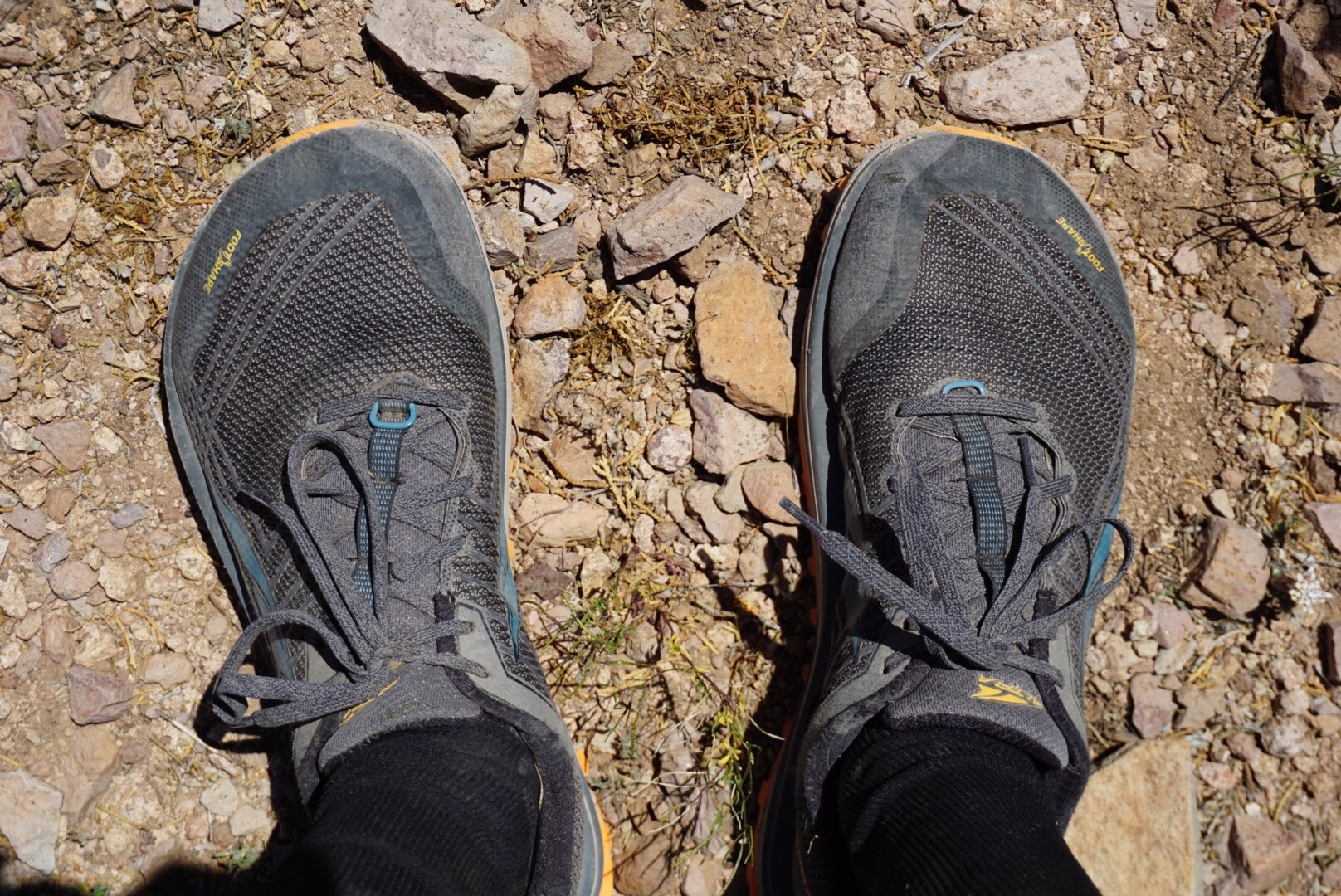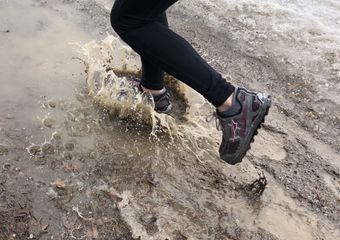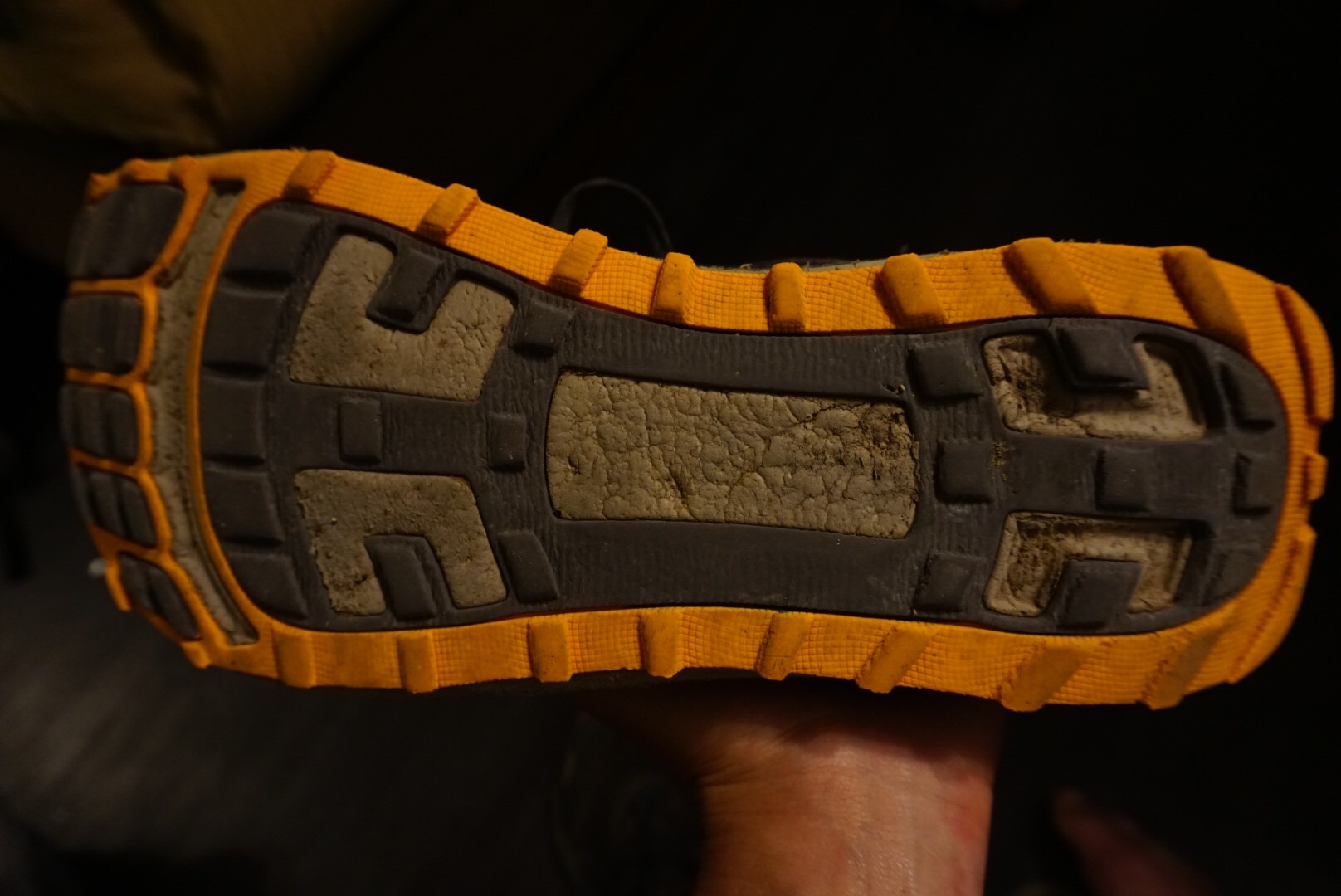Gear Review: Altra Timp 1.5
The Timp 1.5 is a zero-drop trail running shoe from Altra that hits a sweet spot of cushioning between their popular Lone Peak and their max-cushioned Olympus. Like the Lone Peak, which is perhaps the most popular shoe among thru-hikers, the Timp 1.5 is well suited for lightweight backpacking. The generous cushioning, aggressive outsole, roomy toe box, and zero drop make it an ideal shoe for hiking long days on long trails. The testing grounds for this review were the first 425 miles of the CDT in New Mexico on surfaces ranging from moderate, well-graded trail, steep and loose rock, paved road, and the never-dry conditions encountered in the Gila River Canyon.
Altra Timp 1.5 At-a-Glance
Weight (pair): 21 oz
MSRP: $130
Stack height: 29 mm
Drop (difference from heel to toe): 0 mm
Support: neutral
Fit

The wide toe box allows plenty of room for your toes to wiggle and splay. The fit tapers toward the midfoot and heel for a secure fit.
The Timp 1.5 features the classic Altra fit: a very wide and roomy toe box tapering to a more traditional fit in the mid foot and heel. From what I can recall having only tried on the original Timp in a store, the toe box is not quite as wide on the 1.5. It is similar in fit to the Superior and a bit wider than the Lone Peak 4. Fans of the Lone Peak 3 and 3.5 should note that the Timp 1.5’s toe box is quite a bit wider.
As someone with pretty wide feet, I find this fit to be excellent for all-day comfort on the trail as it allows my toes to splay, which helps prevent rubbing and blisters. I think even those with average shaped feet will appreciate the extra space in what Altra calls their “foot shaped” toe box. Those with narrow feet may find the fit to be sloppy or insecure.
The Timp 1.5 is almost true to size but a little on the short side. I’d recommend trying both your usual size and a half size up.
Comparisons
Timp 1.5 vs. Lone Peak 4.0
Having only tried the Lone Peak 4 in a store, I can offer little in the way of comparison. But I will say that the midsole of the Timp 1.5 feels more bouncy and responsive and the notch up in cushioning is noticeable.
Timp 1.5 vs. Superior 3.0
The shoe I have used the most for backpacking is the Superior 3.0, which is very similar to but wider than the Superior 3.5. Both of these models are far less cushioned and lower to the ground than the Timp 1.5. They are also more flexible, although the Timp is by no means a stiff shoe. While I loved the qualities of the Superior, I found myself wanting a bit more support, a more durable construction, and more cushioning. I also wanted a shoe that would require less frequent replacement.
As much as I enjoyed the Superiors, I now feel they are more suited to trail running than backpacking. With the Superior 4.0 moving further in this direction with its sock-like upper, I knew I had to find a new backpacking shoe.
I chose the Timp over the Lone Peak because the fit and overall feel are closer to the Superior.
Midsole

The super cushioned midsole is soft yet responsive and provides excellent protection from rocks.
The midsole strikes a very nice balance between cushion and responsiveness; it is soft but not marshmallow-y and there is a bit of spring to the push-off. The amount of cushion doesn’t allow for much ground feel, which is fine on well-groomed trails or dirt roads but a disadvantage on more technical terrain. Unfortunately, one must usually sacrifice ground feel for greater protection and the Timp is no exception. If you’ll frequently be venturing onto technical trails or off-trail, I would look for a shoe that is lower to the ground as the high stack height is a bit unstable on technical terrain. In fact, I found myself wishing for a slightly leaner shoe when descending some steep loose rock on an off-trail alternate route. Of course, the positive side of the high stack height is that even sharp rocks cause little to no discomfort underfoot. After 425 miles of use, I have only noticed a minor decrease in cushion and response, which is quite encouraging.
Outsole
The tread pattern of the Timp is familiar to me as it is nearly identical to that of the Superior 3. The outsole is moderately aggressive and feels secure on a variety of surfaces. It grips smooth rock very well and performs adequately on loose rock and dirt. I found myself sliding a bit in the mud, so the lugs may not be quite deep enough for really messy conditions. Although I have not yet used this shoe in the snow, I imagine it would bite reasonably well in soft, moderate-angle snow based on my experience with the Superior. The tread is holding up pretty well although the lugs have definitely been rubbed down a few millimeters and no longer offer the same grip as when new. One lug appears to be pealing away from the EVA foam on the right shoe although this hasn’t caused any problems. Speaking of the EVA foam, it appears to be exposed on small parts of the outsole, presumably to save weight, although I haven’t yet noticed increased wear in these areas like you might expect.
Upper

The upper is reasonably protective while remaining soft, flexible, and comfortable—two thumbs up. The toe cap is rigid enough to protect from the accidental kicking of rocks and doesn’t attribute to any rubbing or discomfort. In fact, the feel of the interior of the upper is very nice and allows me to use the shoe with thin socks. The only downside I can see to the upper is that it may not be rigid enough for kicking steps into snow. To be fair, this was designed as a trail running shoe, not a backpacking shoe, and this would not be a concern for runners or even most hikers. It could, however, be a deciding factor for a thru-hiker choosing between the Timp and the slightly more rigid upper of the Lone Peak 4. I would rate the durability of the upper so far as excellent. I have not managed to put even a small hole in it. I believe this is due to the subtle, yet effective reinforcements that Altra has placed in common blow-out areas such as above the pinky toe (from my observations an area of concern on the original model Timp).
Overall Durability
The durability of this shoe has shown to be quite good for a trail runner. The midsole has retained most of its cushion, the upper has shown close to zero signs of wear, and the outsole still has some life in it. The outsole will wear out before the rest of the shoe and ultimately be the cause for replacement. I plan on using these shoes for another 150 miles as I’ll be getting into some snowy conditions and would like fresh lugs. For average conditions on a long distance hike, I would predict getting between 500-700 miles out of a pair before you’ll be wishing for more traction. If hiking a particularly mellow section, I’d probably be willing to stretch them past 800. I’d love to see Altra improve the durability of the outsole so that hikers and runners could take full advantage of the excellent midsole and upper.
Breathability and Dry Time
The Timp 1.5 does a great job in this category. When worn with thin socks, my feet stayed dry and comfortable hiking all day in 80-90 degree heat in southern New Mexico. The Timp manages to offer excellent breathability without letting in excessive dirt and dust through the mesh upper. The dry time is acceptable although not as good as I recall with the Superior 3.0. The insole tends to hold on to water and sometimes needs to be removed in order to dry completely. This was only an issue when the shoe got totally soaked and was only a minor annoyance. If doing just a single river ford in warm, sunny weather, I’d imagine the shoe will dry 90% after a few hours of hiking save for a bit of moisture under the insole.
Who Will Like the Timp 1.5?
This shoe really shines (ha) on moderate, well-maintained trails. It would be a great choice for normal season hikes on popular long trails like the PCT or JMT. Your feet will appreciate the generous cushion and roomy fit after a long day on the trail and you’ll get a lot of use out of each pair.
Who Should Look Elsewhere?
If you’re someone who is regularly engaged in steep, rocky pursuits, such as peakbagging in the Northeast or off-trail high routes out West, I’d personally look for a shoe that is lower to the ground. The Lone Peak would be a step in the right direction with its slightly lower stack height and more substantial upper. I would think the Altra King MT 1.5 would probably be the way to go for such conditions, although I have not personally tried it.
This website contains affiliate links, which means The Trek may receive a percentage of any product or service you purchase using the links in the articles or advertisements. The buyer pays the same price as they would otherwise, and your purchase helps to support The Trek's ongoing goal to serve you quality backpacking advice and information. Thanks for your support!
To learn more, please visit the About This Site page.






Comments 4
Is Altra discontinuing the Timp? It is discounted many places and they don’t list it with other trail runners in their marketing materials.